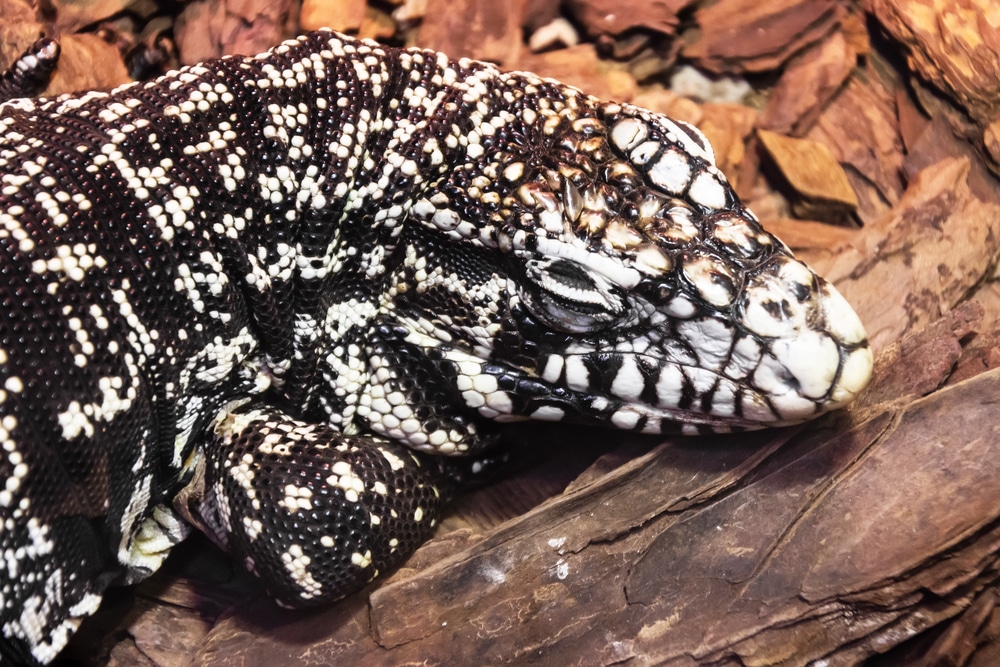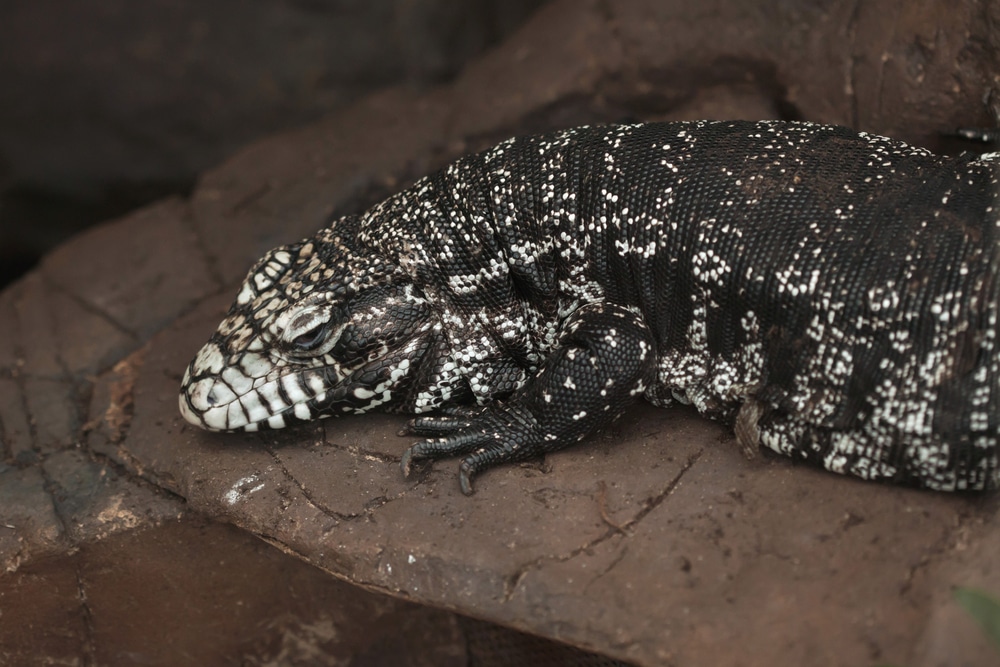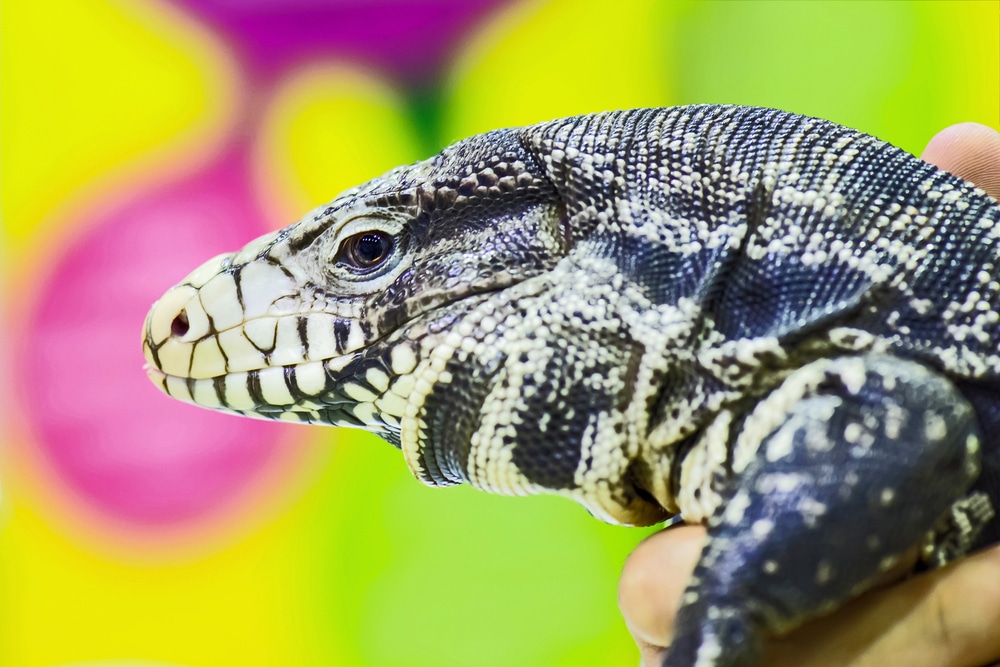Reptile enthusiasts who are fond of large lizards have a relatively limited number of species to choose from.
Some gravitate towards iguanas, and others are drawn to monitor lizards, but a relative handful prefer keeping members of a slightly less popular group: the tegus (Tupinambis).

That’s a shame, as tegus are very interesting animals, who can make very rewarding pets. But, as when keeping any reptile, establishing and providing an appropriate habitat is imperative for success. Tegus do exhibit some challenges with respect to their housing, but they don’t require anything that dedicated keepers can’t provide.
We’ll try to help such keepers below, as we explain the best way to set up a tegu enclosure. This includes everything from selecting the enclosure itself to establishing a proper thermal gradient and decorating the habitat. With ample effort and a bit of luck, you – and, more importantly, your lizard – can enjoy a top-notch tegu habitat.
Quick Navigation
Tegu Enclosure Basics: What You Need to Know
To establish a suitable enclosure for your tegu, you’ll need to understand a few basic principles and details first. We’ll discuss some of these points in greater depth later, but we’ll begin by trying to help paint an overall picture of your tegu’s ideal habitat.
- Although tegus vary in size, most are relatively large and active lizards. This means that most will require very spacious enclosures – occasionally large enough to be considered “room size.”
- Tegus hail from tropical and subtropical climates, so most keepers will need to set up heating devices for their pet’s habitat. Obviously, it’ll also be necessary to install thermometers to monitor the enclosure temperatures.
- Like many other ectothermic animals, tegus often regulate their body temperatures by moving between microhabitats of different temperatures. You’ll need to provide your pet with the ability to do the same thing in captivity, primarily by the establishment of a thermal gradient.
- A variety of substrates will work for tegu maintenance, and different keepers have different preferences. In any event, you’ll need to consider the differences between the most commonly used substrates and pick the one you think most appropriate for your situation.
- Despite moving around freely while hunting or foraging for fruit, seeking mates or acquiring other resources, tegus spend a great deal of time hidden from predators. And even though your lizard doesn’t need to worry about predators, he’ll remain oblivious to this fact. Accordingly, you’ll need to provide him with at least one (and preferably several) hiding places inside the enclosure.
- Tegus aren’t especially aquatic, but they do require appropriate humidity levels. They’ll also require a dish of clean, fresh water available for drinking purposes.
- Once you set up the habitat, you’ll need to maintain it regularly. This not only includes monitoring the temperatures and keeping the water dish filled, you’ll need to clean the habitat regularly too.
Having reviewed the basics of your tegu’s enclosure, we can now discuss the specific things you’ll need to provide when setting up your pet’s habitat.

Selecting the Enclosure
The first thing you’ll need to do when considering purchasing a tegu is to buy and setup the actual enclosure – the box which will contain your pet’s world. This is an important decision, and it’ll influence your tegu-keeping experience in myriad ways.
Deciding on the ideal enclosure will require you to consider a variety of criteria. We’ll discuss some of the key factors you’ll need to consider below:
Style
Glass aquaria are probably the most popular enclosure style keepers use for tegu maintenance. The primary reason for this is that aquaria are easy to find and acquire, and they’re usually pretty affordable. However, they exhibit a number of problems, which make them less than ideal for tegu maintenance.
For starters, they’re rarely available in large enough sizes for large tegus. They’re also fragile, heavy, difficult to move and poorly insulated, making them difficult to heat. Aquaria can make suitable enclosures for young or small tegus, but you’ll likely want to move on to a better enclosure style as your lizard grows.
Commercially built plastic reptile cages are likely the best option for most keepers. These types of enclosures are designed in reptile-appropriate dimensions, they feature front-opening doors, and they’re often equipped with features that make them easy to heat. Plastic enclosures are also light, durable and easy to move around.
Some keepers prefer instead to build a custom enclosure themselves. This is acceptable for those with some experience, as well as the materials and skills necessary to construct the habitat.
Size
Keepers have varying opinions regarding the proper size for a tegu enclosure. For young lizards, a 10- or (preferably) 20-gallon aquarium or plastic enclosure of similar size is acceptable. However, large lizards (those exceeding 24 inches or so) will require much larger enclosures, and very large individuals will require truly gigantic habitats.
As a rule of thumb, you’ll want to try to provide an adult tegu with at least 8 square feet of space, and 16 square feet would be preferable. Many of the most successful professional tegu breeders provide even larger habitats than this.
Despite uniformed statements to the contrary, you can provide your pet with a habitat that is as large as you like – you’ll just need to make sure that your pet has plenty of hiding places and visual barriers within it. This will prevent him from feeling “exposed” or “vulnerable.”

Heating and Lighting the Habitat
Replicating tropical or sub-tropical conditions for your tegu requires that you install heating and lighting devices in the habitat. There are a variety of ways to do so, but we’ll try to outline one of the easiest approaches below.
While heat and light are separate resources for your pet, it is possible – and easiest – to provide them to your lizard by utilizing heat lamps. Heat lamps obviously produce heat, but they also yield light, which will promote proper behaviors and allow your lizard to see.
It is worth noting that some lizards require specific wavelengths of light to remain healthy. This can complicate the method by which light and heat are provided, but fortunately for tegu keepers, these lizards do not appear to require UVB lighting. There’s likely no harm in providing it, but it doesn’t appear to be strictly necessary – likely because they’ve evolved to eat whole prey items.
Whether you intend to utilize lights that provide UVB or not, you should be sure to provide your lizard with the highest quality light possible. Whichever type of lights you use, you’ll want to use them in conjunction with metal lamp shrouds to help direct the heat into the enclosure.
Rather than simply placing the heat lamps over the middle of your tegu’s enclosure, you’ll want to place the heating devices at one end of the habitat. This will make one side of the enclosure quite warm, while temperatures will gradually fall with increasing distance. This is known as a thermal gradient, and it is an invaluable strategy for tegu maintenance. Among other things, it’ll allow your pet to choose which temperature he’d like to be, rather than you dictating it to him.
You’ll have to experiment with bulb wattage to ensure your lizard has access to temperatures in the appropriate range (typically around 95 to 105 degrees Fahrenheit directly under the lamp). The cool side should usually be as cool as is possible, with the ideal temperature range being the low- to mid-70s. Just be sure to monitor the temperatures regularly with a thermometer.
Of course, some keepers prefer using heat pads or radiant heat panels to provide warmth for their lizard. This is acceptable – if, arguably, less than ideal. But you should still situate the heating devices at one end of the enclosure to establish a thermal gradient, or range of temperatures.
Substrate Selection
A variety of substrates will work for tegu maintenance, and each offers a variety of pros and cons. We’ll discuss some of the most common choices below:
- Newspaper – Newspaper is nice because it is easy to use and change, and it is essentially free. It also makes it easy to keep the habitat clean and hygienic. The downsides to newspaper include the fact that it isn’t attractive, doesn’t allow burrowing behavior, and can occasionally make it hard for your lizard to get traction for walking.
- Cypress Mulch – Cypress mulch is the author’s preference for tegu maintenance. It is very affordable, it looks relatively attractive, and it is easy to spot-clean as necessary (unlike newspaper, which must be completely replaced once soiled). Cypress mulch also retains water well, making it great for high-humidity applications.
- Orchid Bark – Orchid bark is similar to cypress mulch in most ways, except that it is (arguably) more attractive, and much more expensive. This may not be a problem for small enclosures, but it may be cost prohibitive to use for large tegu habitats.
- Soil – Soil can make a good substrate for tegu maintenance, as it looks nice, retains humidity and facilitates the construction of burrows. However, you’ll want to stick to soil you collect your self or organic varieties without any additives. Do note that soil can also be a bit messy and leave a layer of dust around the habitat (and surrounding room).
- Recycled Paper Products – Recycled paper products are usually sold in pellet form, so they offset some of the drawbacks of newspaper. However, they also cost more than newspaper and may present a (minor) ingestion hazard. They also tend to become worthless once wet, but some keepers still like to use this type of substrate.
There are a few other substrates used on occasion, including sand, gravel and ceramic tile. However, these substrates are imperfect choices for a variety of reasons and are best simply avoided by beginning tegu keepers.
Habitat Furniture
Not that you have a physical enclosure for your pet, you’ve established a lighting and heating system, and you’ve added a substrate, it is time to discuss some of the items you’ll need to place inside the habitat – the enclosure furniture, if you will.
Fortunately, tegus do not require as much habitat furniture as some other reptiles do, but you will need to include a few things in your pet’s habitat. The most notable thing you’ll need to add to the enclosure are hiding places. Tegus remain hidden for much of the time, so you’ll need to provide your pet with somewhere dark and confined, in which he can feel safe.
Minimally, you’ll need to provide one hiding place for your lizard. However, it is preferable to provide your pet with several hiding places, scattered around the habitat in places with different temperatures. This will prevent your pet from having to choose between security and his preferred temperature.
You can use a variety of things for hiding places. Commercially manufactured plastic hide boxes are certainly the simplest option, but things like cork bark and half-logs will also work.
- Hand Picked and Packed
You can also dig burrows for your lizard, provided that the substrate allows you to do so and you can do it in a safe manner that precludes tunnel collapse.
Tegus aren’t terribly arboreal, so they certainly don’t require climbing branches. However, there is no reason you can’t include a few good branches if you like. Your lizard may never utilize them, but they won’t cause him any harm either.
Drinking Water and Humidity
Like most other lizards, tegus require access to clean, fresh water at all times. Tegus – unlike some other lizard species – will readily drink from a water dish, making it easy to address their water needs.
The water reservoir needn’t be especially large, but you can utilize one large enough to allow your pet to swim. However, if you do so, you’ll need to commit to cleaning it very frequently, as your pet will surely defecate in the water regularly. Most keepers find that regular tap water will suffice for their pet’s drinking water needs, but some keepers prefer to use bottled water instead. Just avoid using distilled water, as it can lead to mineral imbalances.
In addition to drinking water, you’ll also need to ensure the enclosure remains suitably humid. Tegus do not require the super-saturated conditions than some other lizards do, but they may experience shedding difficulties and suffer from respiratory infections if kept too dry.
Maintenance: Keeping the Enclosure as Good as New
Of course, you aren’t done after setting up your pet’s habitat — you’ll need to invest some time and energy to keep your tegu’s enclosure clean, safe and looking great over the long term. Fortunately, this isn’t terribly difficult, and it is much easier than, say, maintaining a fish aquarium.
While the specifics will vary from one situation to the next, maintaining a tegu habitat will generally involve the following:
- Daily spot cleaning, including the removal of feces, urates, loose insects, or pieces of shed skin.
- Misting the habitat regularly to ensure the humidity level remains correct.
- Emptying, cleaning and refilling the water reservoir on a daily basis.
- Cleaning the enclosure walls (or glass) on a weekly basis.
- Monitoring the temperatures on a daily basis.
- Replacing heat lamps or other devices as they burn out or fail.
Additionally, you’ll need to do a thorough enclosure cleaning about once per month. During these cleaning sessions, you’ll want to remove and replace all of the substrate, sterilize the water dish and any cage furniture you don’t want to replace, and scrub the walls of the habitat.
Conclusion
Setting up a tegu enclosure is certainly more complicated than throwing together a habitat for, say, leopard geckos. But fundamentally, the principles are all similar – everything is just “super-sized” a bit. Nevertheless, if you want to keep one of these amazing lizards, this is what you’ll need to do.
Just be sure to keep the principles discussed above in mind, but don’t be afraid to experiment – particularly if you already have some experience setting up enclosures for other lizards. Keep your pet’s best interests in mind and be ready to make adjustments if things don’t work out, and you’ll likely be well on your way to tegu-keeping success.
Last update on 2025-04-25 / Affiliate links / Images from Amazon Product Advertising API
